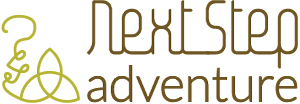Find your true nature. Then resist it. We’ve been exploring this concept in yoga lately, and often the question is why? Another is how? Here’s a story that answers both questions.
Back in 2004 (thanks Beth!) we built the Adventure Learning Center. We scheduled training with Junior from Wisconsin. I loved Junior. I probably owe him my life. I certainly owe him insight into my true nature.
I spent the first two days of training on the ground. This was possible since we started on the low course where elements are only twelve to eighteen inches high. To be honest, I was actually a little scared of those!
When we did play around on the highs, I carried ladders with my friend Jeff who was also determined to remain grounded. We learned to belay really well. Then at the end of Day Two Junior told us the last three days of training would be exclusively on the high course, 40-60 feet above the ground.
I lay awake Tuesday night, filled with fear. Some people dream of flying. I dream of falling. One thing you do with fear is look for ways to avoid doing the thing you’re afraid of.
I decided I’d “experience” the high elements, but not set them up. I could stay on belay and I wouldn’t have to set up the belay system that could mean life or death to a climber. Seemed reasonable to me.
Until that morning when we got to the ALC. Junior put us into four groups of three and told us our first task was to climb a pole, set up and take down its element. I could no longer see a reasonable way to avoid climbing and setting up.
I don’t ask others to do things I’m unwilling to do myself. So, climb I would. The tower held a cargo net and a giant ladder as well as the climbing wall. Setting up meant fastening the belay system to a cable running above my reach around the perimeter of the tower.
We set a ladder against the northeastern telephone pole and lashed it to the pole with bungee cords. I don’t know who went first, but I’m pretty sure it wasn’t me. I believed my true nature was to stay on the ground. I had a visceral, palpable fear of heights. When we took our kids to the Rockies, I spent a good deal of time pulling the boys back from the edges of cliffs.
Making it to the top of the ladder wasn’t so bad, but then finding the giant staples sticking out of the pole, getting a purchase on them and figuring out where my left foot should go was another huge challenge. Especially since I was shaking.
Not only was the footwork challenging, but I was using lobster claws for the first time (I was also on belay thank god). By the time I got to the top and locked the carabiners on the cable I was shaking AND crying.
I had bruised and cut my legs and arms reaching for staples and navigating the railing, but there I was at the top with task accomplished. Cheers came up not only from Eric and Corinne but from the whole group. I had done what I never expected to do. I had resisted my nature.
Over the next two years I gained confidence in my ability to set up the belay system correctly, keep at least one lobster claw clipped to my harness and one to the pole. I learned to love being perched at the top of a gently swaying telephone pole, just a little closer to flying in the clouds.











